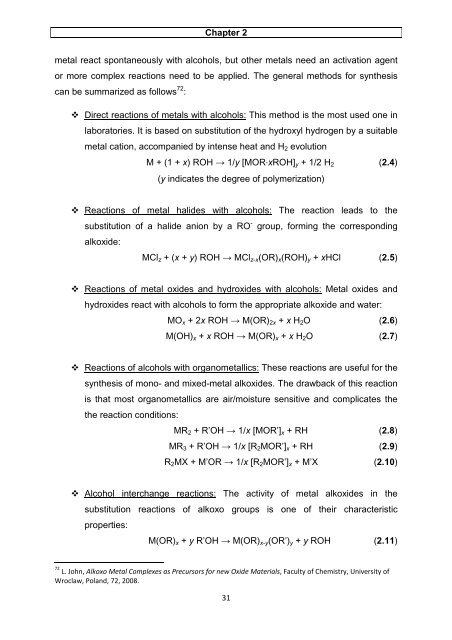A solution and solid state study of niobium complexes University of ...
A solution and solid state study of niobium complexes University of ...
A solution and solid state study of niobium complexes University of ...
Create successful ePaper yourself
Turn your PDF publications into a flip-book with our unique Google optimized e-Paper software.
Chapter 2<br />
metal react spontaneously with alcohols, but other metals need an activation agent<br />
or more complex reactions need to be applied. The general methods for synthesis<br />
can be summarized as follows 72 :<br />
Direct reactions <strong>of</strong> metals with alcohols: This method is the most used one in<br />
laboratories. It is based on substitution <strong>of</strong> the hydroxyl hydrogen by a suitable<br />
metal cation, accompanied by intense heat <strong>and</strong> H2 evolution<br />
M + (1 + x) ROH → 1/y [MOR∙xROH]y + 1/2 H2 (2.4)<br />
(y indicates the degree <strong>of</strong> polymerization)<br />
Reactions <strong>of</strong> metal halides with alcohols: The reaction leads to the<br />
substitution <strong>of</strong> a halide anion by a RO - group, forming the corresponding<br />
alkoxide:<br />
MClz + (x + y) ROH → MClz-x(OR)x(ROH)y + xHCl (2.5)<br />
Reactions <strong>of</strong> metal oxides <strong>and</strong> hydroxides with alcohols: Metal oxides <strong>and</strong><br />
hydroxides react with alcohols to form the appropriate alkoxide <strong>and</strong> water:<br />
MOx + 2x ROH → M(OR)2x + x H2O (2.6)<br />
M(OH)x + x ROH → M(OR)x + x H2O (2.7)<br />
Reactions <strong>of</strong> alcohols with organometallics: These reactions are useful for the<br />
synthesis <strong>of</strong> mono- <strong>and</strong> mixed-metal alkoxides. The drawback <strong>of</strong> this reaction<br />
is that most organometallics are air/moisture sensitive <strong>and</strong> complicates the<br />
the reaction conditions:<br />
MR2 + R’OH → 1/x [MOR’]x + RH (2.8)<br />
MR3 + R’OH → 1/x [R2MOR’]x + RH (2.9)<br />
R2MX + M’OR → 1/x [R2MOR’]x + M’X (2.10)<br />
Alcohol interchange reactions: The activity <strong>of</strong> metal alkoxides in the<br />
substitution reactions <strong>of</strong> alkoxo groups is one <strong>of</strong> their characteristic<br />
properties:<br />
M(OR)x + y R’OH → M(OR)x-y(OR’)y + y ROH (2.11)<br />
72 L. John, Alkoxo Metal Complexes as Precursors for new Oxide Materials, Faculty <strong>of</strong> Chemistry, <strong>University</strong> <strong>of</strong><br />
Wroclaw, Pol<strong>and</strong>, 72, 2008.<br />
31
















